Images
Flags
Greek Flags Through The Centuries
War Of Independence
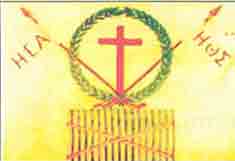 |
The oldest flag of the War of Independence. The instructions for its design were given by Paleon Patron Germanos [People]. It contains the signs of the Friends who were in charge of the Society's logistics [The Society]. It was raised by Georgios Sisinis {Γεώργιος Σισίνης} at Ilis {Ίλις}, in 1821. It is kept in the National Historical Museum. |
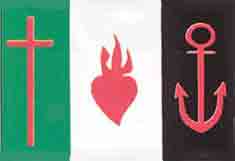 |
The flag of Areopagus {Arios Pagos ~ Άρειος Πάγος}. It was raised in the Eastern Greek Wasteland on January 19th, 1821. The Cross symbolizes the just cause of the Nation. The flaming heart symbolizes the purity of the Struggle. The anchor symbolizes the dedication to the mission. |
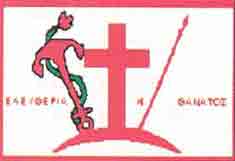 |
The flag of Spetses {Σπέτσες} island. The Cross symbolizes Christianity and the equity of the Struggle. The reversed crescent symbolizes Islam and the fall of the Ottomans. The lance symbolizes the strength of the Greeks. The anchor symbolizes the dedication to the Struggle. The letters read "Ελευθερία ή Θάνατος" {Eleftheria i Thanatos}, that is "LIBERTY OR DEATH". |
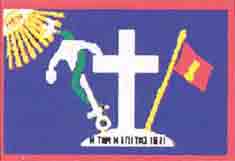 |
The flag of Idra {Ύδρα} island. The Cross symbolizes the sanctity of the Struggle and the snake symbolizes Justice. The islanders thought of the Ottomans as the snake that "eats the eggs of the Nation". The words read "Ή τάν ή επί τάς" {I tan i epi tas}, that is "WITH IT OR ON IT" [Definition]. |
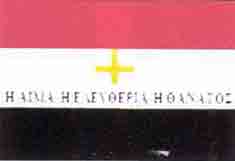 |
The flag of the Chieftains at Agrafa {Άγραφα}. Every nucleous of resistance and any kind of uprising of the enslaved Greeks (even when unco-ordinated), had its own special flag, whose concept belonged to the chieftain of the area. The letters read "Ή αίμα ή ελευθερία ή θάνατος" {I ema i eleftheria i thanatos}, that is "EITHER BLOOD OR LIBERTY OR DEATH". |
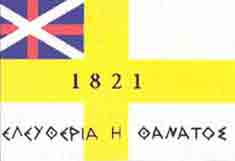 |
The flag that was later used by Andreas Miaoulis [People]. The letters in the flags of Spetses {Σπέτσες} and Psarra {Ψαρρά} islands, read "Ελευθερία ή Θάνατος" {Eleftheria i Thanatos}, that is "LIBERTY OR DEATH". |
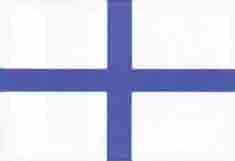 |
The flag of the Kolokotronis family with the Blue Cross of Saint Andrew. The Kolokotronis family started using this flag since the end of the 18th century. Theodoros Kolokotronis [People] started using this flag in 1806. |
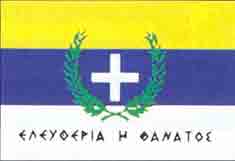 |
The flag of Sea Captain Georgios Sahtouris {Γεώργιος Σαχτούρης} (1783-1841) from Idra {Ύδρα} island. The flags of big Aegean islands were quite similar to each other and contained profound allegoric signs indicative of the Society of Friends [The Society]. The letters read "Ελευθερία ή Θάνατος" {Eleftheria i Thanatos}, that is "LIBERTY OR DEATH". |
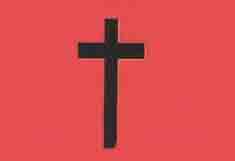 |
The flag of Andreas Londos {Ανδρέας Λόντος} (1786-1846) during the first year of the War of Independence. Under this flag on March 21st, 1821, he captured the fort in Patras {Patre ~ Πάτραι}. This flag was later blessed by Paleon Patron Germanos [People] in Saint George square. |
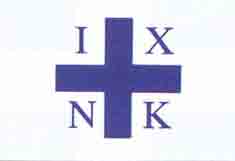 |
The flag of Dimitrios Plapoutas {Δημήτριος Πλαπούτας} (1786-1864). It is one of the many flags used during the first year of the War of Independence. A blue Cross on a white background and the letters "ΙΧΝΚ" which mean "Ιησούς Χριστός ΝιΚά" {Iisous Hristos Nika}, that is "Jesus Christ Conquers". |
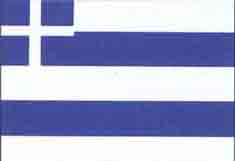 |
The flag of fire-raiser Konstandinos Kanaris [People]. |
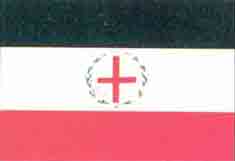 |
One side of the flag of Aleksandros Ipsilandis [People]. A red Cross encircled by a wreath of laurel and the words "Εν Τούτω Νίκα" {En Touto Nika}, that is "IN HOC SIGNO VINCES" [Definition]. The other side contains the Phoenix, the magical bird, and the words "Εκ τής στάκτης μου αναγεννώμαι" {Ek tis staktis mou anagennome}, that is "I ARISE REBORN OUT OF MY ASHES". |
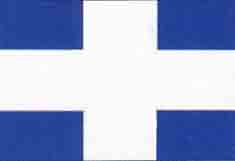 |
The flag of Armatolos {Αρματολός) (name for those charged with the security of certain areas under Ottoman occupation) Ioannis Stathas {Ιωάννης Σταθάς}. Yet another flag used by the enslaved Greeks, that looked very much like the official Land Flag of Greece. Ioannis Stathas was born on Skiathos {Σκιάθος} island and in 1800 flew this flag on the ships of his flotilla. |
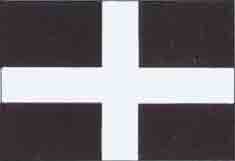 |
The flag of the Unknown Sea Captain. The black colour symbolizes enslaved Greece that struggles to gain independence. |
Source: Military Review.
01-20-2005